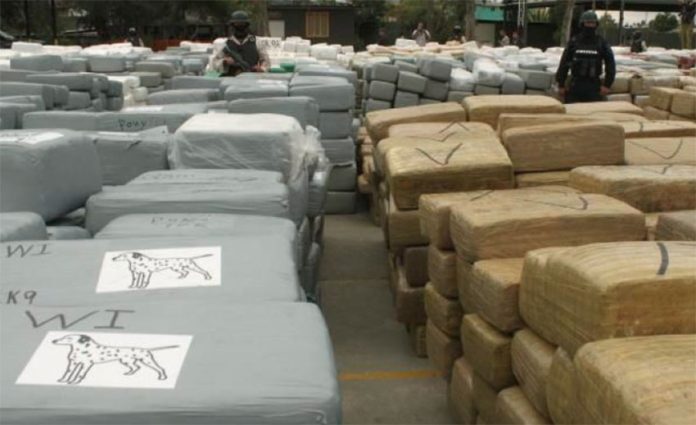Sitting on a dirty sidewalk in the Mexican border city of Tijuana, Patrick Bejarano cradles a syringe in his hand, getting ready to shoot up a mixture of white powder and water.
“It’s fentanyl,” he grins. “Heroin no longer gets me high and this is much stronger and cheaper. Fentanyl is pure rush and that’s what we look for.”
For more than half a century, Tijuana has been a manufacturing hub — churning out electronics, medical devices and components for aircraft and cars from factories on the doorstep of the U.S. But Bejarano is a link in a newer cross-border supply chain: synthetic drugs.
“For the cartels in Mexico, the biggest profits now come from methamphetamines and fentanyl,” says Mike Vigil, a former chief of international operations for the U.S. Drug Enforcement Administration (DEA).
U.S. authorities say Mexico is already the source of 90% of the illicit drugs crossing the border. As Mexico prepares to legalize marijuana, analysts say the lucrative trade in fentanyl will continue to boom, posing a headache for new U.S. President Joe Biden as deaths from synthetic opioids, and drugs laced with them, continue to rise.
Like rival carmakers, Mexico’s two most powerful drug cartels — Sinaloa and Jalisco New Generation — compete to import raw materials, transform them in their factories and export the finished product to the U.S.
Their target market is not people such as Bejarano in Mexico. But, in the same way that Mexicans began buying lots of television sets after the country became a world-leading TV maker, booming domestic use is another sign of how big the fentanyl trade has become in Latin America’s second-biggest economy.
“Security forces say you can calculate drug production from the size of seizures,” says Anabel Hernández, an investigative reporter and author who writes about drug trafficking and organized crime. “The amounts confiscated represent about 10 to 15% of real production.”
On that basis, the trend is worrying. While U.N. data show a 10-fold plunge in marijuana seizures in Mexico in less than a decade — from 2.3 million kilograms in 2010 to 231,000 in 2018 — fentanyl seizures rose nearly 500% last year to 1.3 million kilos, according to Mexico’s defense minister.
Drug cartels have adapted to meet changing demand and have been able to make use of the supply routes into the U.S. that they built up to traffic marijuana, heroin and cocaine.
“Cocaine is still very lucrative,” says Steven Dudley, co-director of Insight Crime, which tracks and analyzes the narcotics trade in the Americas. “But marijuana is yesterday’s news. Fentanyl is today’s news.”

Pot legalization will not wipe out the illicit cannabis trade but synthetics, which are simpler to produce and transport and far more lucrative, “have changed the business incentives,” says Hernández.
Mexico has impounded growing volumes of precursor chemicals and fentanyl pills at airports. Late last year, its authorities also discovered a laboratory in Mexico City with vats two stories tall containing chemicals.
Shipments are increasing, too. Since October 2020 alone, U.S. border officials seized 2,234 kilos of fentanyl — 3% more than they found in the October 2019-September 2020 fiscal year. Fentanyl is also finding its way into heroin and other drugs, making them more addictive and more deadly.
According to the DEA, “since the initial disruption of Covid-19, Mexican cartels have reinforced supplies of precursor materials, increased production and are sending larger fentanyl and methamphetamine loads into the U.S.”
Vigil explains that the cartels dispatch so-called Marco Polos to China to buy precursor chemicals and also the finished fentanyl product. India has emerged as another supplier.
A kilo of fentanyl can be bought online in China for about US $9,000, Vigil says. “Fentanyl is 50 times more potent than heroin and 100 times more potent than morphine. You can cut that and make a lot of kilos. That investment of a little over $9,000 would net you $2 million,” he said.
On the streets of Tijuana, a dose of fentanyl goes for $2.40. One user, Armando, says he does not know if the “China white” — as powdered heroin is known — that he mixes with crystal meth is laced with fentanyl. His body apparently does: in the past couple of months he has overdosed six times. “I’m surprised I’m still here,” he says.
Mexican fentanyl supplies to the U.S. have been increasing since 2019 while the supply of the drug directly to the U.S. from China has “decreased substantially,” according to the DEA.
Once across the border “Mexican traffickers have an advantage: they can mass-produce and undercut even the most wily and entrepreneurial distributors in the U.S.,” Dudley says, using their experience and connections from methamphetamine trafficking.
With Covid-19 and a migrant emergency at the border, drugs have not yet loomed large in bilateral U.S.-Mexico relations since President Biden took over. “But I think the perception in the U.S. is that Mexico isn’t paying enough attention to fentanyl production,” says Cecilia Farfán Méndez, an expert on drug trafficking organizations at the Center for U.S.-Mexican Studies at the University of California San Diego.
Bilateral relations remain strained after a row last year over the brief arrest in the U.S. of Salvador Cienfuegos, Mexico’s former defence minister, and a law that experts say will hamper the intelligence-sharing that is crucial to counter-narcotics efforts.
Mexico destroyed 175 laboratories last year, up by 92% on 2019, but Dudley says more needs to be done on both sides. “All these things are pointing in the wrong direction if you think your only solution is to stop supply,” he says. “It has to be supply and demand.”
© 2021 The Financial Times Ltd. All rights reserved. Please do not copy and paste FT articles and redistribute by email or post to the web.
